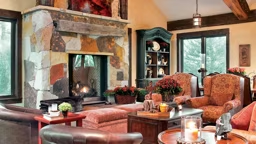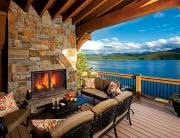
The benefits of living near a body of water are many. For starters, it makes for a mesmerizing view. If it’s large enough, it can be an almost endless source of recreation. If you’re really lucky, you may be able to catch your nightly dinner from it. But even a tiny stream or babbling brook will soothe the soul with its sweet song.
To enjoy your land’s H2O to its fullest requires proper design — siting strategies that will help you take advantage of the views, as well as the power, of the water. These fundamentals will help make sure you’re in the swim of things.
Know Before You Buy
Make sure you understand how — and where — your home can be sited on your waterfront lot. Almost all jurisdictions have “setback” requirements to protect fragile coastlines (which also will preserve your view). These regulations outline how close any construction can be to a lake or stream, and that distance — at least 75 feet or more in many jurisdictions — is measured from the high-water mark, not the shoreline. There are setback requirements for septic systems, as well, to keep the water clean.
Are you lucky enough to have a large, private pond on your property? Consider a geothermal heat pump, which uses a submerged network of pipes and coils to harness the stored solar energy in the Earth and use it to provide your heating needs. To take advantage of this, however, you’ll need a body of water that’s at about one acre in size and 8 feet deep.
If your property is fairly flat, your local jurisdiction may require you to elevate your home on pilings, as is common for beachfront property. This will serve to protect the land and just may save you money on insurance premiums, as pilings greatly reduce your chances of flooding.
Blur the Lines
Today’s building codes emphasize energy efficiency, and that means that today’s windows meet stricter standards and can even function as walls, giving you a full-time view of the water. Look for new designs that slide and telescope into themselves, go around corners or disappear into walls, allowing you and your guests to move from the living room to the patio or deck without any barriers.
Remember to include overhangs or awnings to provide mid-day shade. Today’s sun-resistant fabrics come in a rainbow of colors and patterns and are much more durable and design forward, giving you a seamless look between your indoor and outdoor spaces.
Keep It Simple
Minimalist design and waterfront living go hand in hand. Tile and engineered hardwood floors stand up to coastal weather while providing a clean, easy look. Think sheers and plantation shutters rather than complex window treatments. And for added convenience, talk to your builder about electronic window and shade controls along with television, lighting and security systems: It’s the smart way to customize that beautiful view.
Geothermal Heat Systems: Pond-Loop System
Just a few feet below the surface of the Earth, the ground maintains a fairly consistent temperature, typically 45 to 50 degrees in the northern states and 50 to 70 degrees farther south. A geothermal system can harness this energy to heat your home. Note: You don’t need to have a lake or pond on your property to take advantage of geothermal heat, but having one will reduce the amount of excavation you need to do.






_11868_2023-06-30_11-50-256x288.avif)



